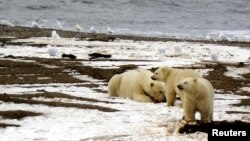For the second consecutive year, the northern reaches of the planet are experiencing unprecedented waves of warm air.
And climate researchers say they've never seen anything like it.
Unprecedented warm weather
To try and understand what is going on, VOA spoke with Mark Serreze, the director of the National Snow and Ice Data Center (NSIDC) based in Denver, Colorado.
The center does all kinds of things, from helping the Navy spot and avoid sea ice, to monitoring the temperatures, weather systems and extent of the sea ice covering the Arctic and Antarctic throughout the year.
The weather pattern of the past two years, according to Serreze, is "unprecedented in my memory."
The unprecedented part is what Serreze calls "pulses of extremely warm air over the [Arctic] Ocean, extreme to the point where at the North Pole it's getting near to the freezing point."
The cause is "an unusual jet stream pattern that has helped to guide lots of very strong storms into the Arctic, coming in from the Atlantic" Ocean.
Jet streams are narrow bands of air that move extremely fast around the globe. The polar jets are the strongest, circling the globe between nine and 12 kilometers above sea level. They can move at more than 100 kilometers per hour.
This winter and last, those polar jets are doing what they always do, picking up a lot of hot moist air from the tropics and pushing it up into the arctic. That's how weather works, Serreze says, moving warm, moist energetic air from the lower latitudes near the equator to higher latitudes at the poles to cool down and release all that energy.
The difference here, he says, is we're experiencing an unusually strong jet stream, combined with unusually strong storms. That combination is creating these pulses of very warm weather.
New normal, or just weather?
Serreze says the research community is now is trying to decide what is going on, and theories generally are falling into two camps.
One camp argues "that this is just one expression of natural variability." Serreze says this may be a weather pattern like El Nino "where weather patterns get stuck for a while." If that's the case, this unusual phenomenon may persist for a few years, and then fade away, to return from time to time.
The other camp is arguing that "the lack of sea ice in critical areas is what is driving this unusual jet stream pattern..."
If that scenario is correct, Serreze says it is worrisome. If a lack of sea ice is causing this jet stream, and the jet stream is raising temperatures, then it becomes a negative feedback loop.
Serreze is quick to point out that there's no real consensus on the cause, because "the reality is that we are seeing these changes unfolding faster than we have the ability to understand them."
He also points out that even with these pulses of warm air, it is still really cold up North, and plenty of ice is still forming, but it's not as much and not as thick as usual. That means we "start next melt season with thinner ice," that is easier to melt.
"We could be setting ourselves up for a very, very low ice flow... and it could hasten an ice-free Arctic Ocean," Serreze said.
The timing on that is unclear, he says, though we could be looking at an ice-free Arctic in the summer months, well before 2100, and perhaps in the next 20 to 30 years.







